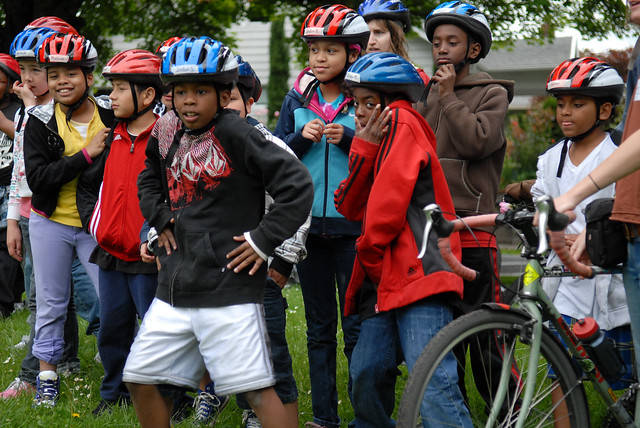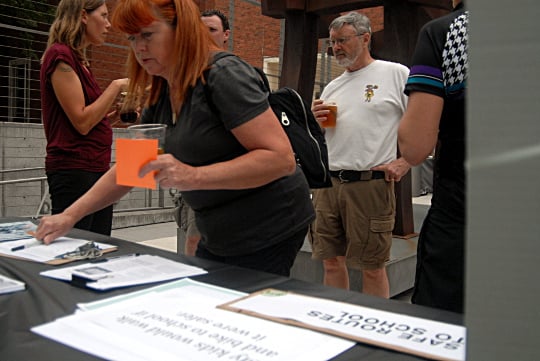
(Photo: J.Maus/BikePortland)
Second in a week-long series about the BTA’s five new advocacy campaigns.
Over the last two years, people trying to reverse the spectacular 40-year slide in the number of kids who bike and walk to school have come to a gradual realization: dedicated federal funding for the Safe Routes to School program is probably gone for good.
“Safe Routes,” as it’s often known for short, paid for in-school walking education workshops for 2nd and 3rd graders, biking education classes for 4th and 5th graders and safety infrastructure like crosswalks and traffic signals near elementary and middle schools.
“Safe Routes [to School] funding is gone, but the basis that was laid over the past 10 years prior to that has really helped show people how effective it can be.”
— Kari Schlosshauer, Pacific Northwest Regional Policy Manager for the Safe Routes National Partnership
But the 2012 federal transportation bill pulled dedicated funding, instead letting states and regions decide whether or not to continue the program using their federal allocations.
In Portland, the program has been so popular that the city and Portland Public Schools began paying for it in 2006 using their own money. This month, a coalition of advocates including the Bicycle Transportation Alliance launched a charge for Metro to use federal funds to do the same thing across the region.
“Safe Routes funding is gone, but the basis that was laid over the past 10 years prior to that has really helped show people how effective it can be,” said Kari Schlosshauer, Pacific Northwest Regional Policy Manager for the Safe Routes National Partnership. “It’s a great time for it. it seems like there’s a lot of desire from it around the region that I’ve seen.”
The strategy, in a nutshell, is to rally suburban families and school districts to convince the Metro regional government that every school deserves the programs that many Portland elementary schoolers already get.
“Gresham’s a great example of a community where there’s a groundswell of interest and support for Safe Routes to Schools among school district personnel, community members, partners,” BTA Deputy Director Stephanie Noll said in an interview. “Folks working in the schools are on board. The one thing that’s missing is funding.”
If it’s to be found, the BTA says that funding would come the place some of the federal money landed after Congress abandoned Safe Routes: in the Metro regional government’s regional flexible fund allocation.
The goal is for $2 million to $11 million every two years, out of a total regional flexible funding pot of $90 million to $120 million.
Advertisement
BTA Advocacy Director Gerik Kransky said the organization hopes to secure that money without forfeiting any of the regional flexible funds that Metro already dedicates to active transportation.
“There’s plenty of room for a $2 to $11 million allocation to safer routes to schools for our kids all across the region without reducing the amount of money we are currently investing in bicycle, pedestrian and transit capital projects,” Krasky said.
Kransky said he sees Safe Routes as a way to build political support for active transportation — sort of nascent American version of the successful “Stop de Kindermoord” movement that kicked off the Dutch embrace of bicycle infrastructure in the 1970s.
And Noll noted that infrastructure around schools is often infrastructure the whole neighborhood can use to get around safely.
“They don’t just serve our schools,” she said. “They make our neighborhoods safer for everyone. But it really makes sense to start with our most vulnerable community members.”
Quick take: BikePortland’s summary of the project
Where the idea comes from: The BTA coordinates Oregon’s Walk + Bike Network, a forum for interested parents, school officials and faculty and other advocates for better student transportation. The concept of metro-level funding developed from their conversations.
Obstacles: Advocates will need to win votes, probably some time in the next year, at JPACT, a Metro committee dominated by suburban politicians, and the regional Metro council.
Likely tradeoffs: Regional flexible funds are in stiff demand because they’re flexible. In the last few years, both TriMet and freight interests have grabbed some of them despite the comparatively small size of the funding stream. To get dedicated Safe Routes funding, it’ll probably need to be perceived not as “more stuff for the bike people” but as a way to support schools and education.
How you could help: Contact BTA Safe Routes to Schools advocate LeeAnne Ferguson: (503) 226-0676 x26 or leeanne@btaoregon.org. Sign the BTA’s petition to Metro. Attend the Safe Routes coalition meeting at 2 p.m. this Thursday, Aug. 28, at Woodstock Library.
Check back each day this week for another post in our series about new advocacy campaigns.


